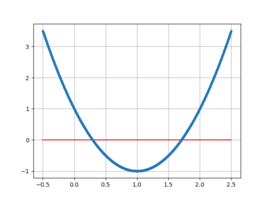Alex McCaile
New member
- Joined
- Sep 28, 2023
- Messages
- 2
Hi!
This is my first ever question on freeMATHhelp. I have been working with ineqialities examples, and I struggle a little bit with the logic. I will first write the text og the example and what I struggle with.
The solution text: " Given inequality 2x^2+1 > 4x The inequality 2x^2+1 > 4x is equivalent to 2x^2-4x+1>0. The corresponding quadric equation 2x^2-4x+1=0, which is of the form Ax^2 + Bx + C = 0, can be solved by the quadric formula. The given inequality can be expressed in the form (x-(1+1/2sqrt(2))(x-(1-1/2sqrt(2)) > 0. This is satisfied if both factors on the left side are positive or if both are negative. Therefore, we require that either x<1-1/2sqrt(2) or x>1+1/2sqrt(2). The solution set is the union of intervals ( -∞, 1-1/2sqrt(2)) ∪ (1+1/2*sqrt(2), ∞)"
This is what I dont understand:
This is my first ever question on freeMATHhelp. I have been working with ineqialities examples, and I struggle a little bit with the logic. I will first write the text og the example and what I struggle with.
The solution text: " Given inequality 2x^2+1 > 4x The inequality 2x^2+1 > 4x is equivalent to 2x^2-4x+1>0. The corresponding quadric equation 2x^2-4x+1=0, which is of the form Ax^2 + Bx + C = 0, can be solved by the quadric formula. The given inequality can be expressed in the form (x-(1+1/2sqrt(2))(x-(1-1/2sqrt(2)) > 0. This is satisfied if both factors on the left side are positive or if both are negative. Therefore, we require that either x<1-1/2sqrt(2) or x>1+1/2sqrt(2). The solution set is the union of intervals ( -∞, 1-1/2sqrt(2)) ∪ (1+1/2*sqrt(2), ∞)"
This is what I dont understand:
- "This is satisfied if both factors on the left side are positive or if both are negative". Why should the factors both be positive or negative?
- What is the union of intervals? What is the logic behind unions?

